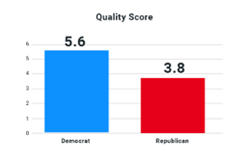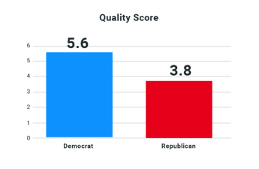
Vaccine Ads Capture Attention Of Democrats More than Republicans
Polarization, social values and institutional distrust can easily override otherwise factual health information in a public health campaign.
NEW YORK (PRWEB)
July 14, 2021
Realeyes, a pioneer and leader in video attention measurement, today released new research showing how the efficacy of public service announcements (PSAs) promoting COVID-19 vaccination varies across race and political groups in the U.S.
Using front-facing cameras and the latest attention AI to measure opt-in viewers, The Realeyes Vaccine Report revealed performance across 12 prominent videos. They were released by health agencies and advocacy groups like The Ad Council, The Creative Coalition, and the Department of Health and Human Services (HHS), as well as the pharmacy-retailer Walgreens and pharmaceutical company Pfizer. Realeyes Quality Score gave each video a rating of 0-10, determining a video’s ability to capture and retain attention live in market.
Vaccine Ads Capture Attention Of Democrats More than Republicans
According to the report, the PSAs scored 38% higher in attention performance among Democrats than Republicans, with average Quality Scores of 5.6 and 3.8, respectively.
The highest-scoring ads differed across political parties. For Democrats, “Should I get it,” from the Ad Council, and the Morgan Freeman ad “Be there,” from The Creative Coalition, scored highest. The ads, with Quality Scores of 7, contained a science-led message backed up by trust.
By contrast, the two highest-scoring ads among Republicans were “It’s Time,” from the HHS, and the “Worship” 30-second spot, from the Ad Council. The sentimental and religious messages of these ads, with Quality Scores of 7, may have contributed to their ability to capture and retain attention among a conservative audience.
White Viewers Most Attentive To Vaccine Videos
The vaccine ads scored a whole point higher on Quality Score when seen by White viewers versus Black and Hispanic viewers. The average Quality Scores of the PSAs were: 3.6 among Asian viewers; 3.4 among Black viewers; 3.4 among Hispanic viewers; and 4.4 among White viewers.
There is a lack of consistency in the top-scoring ads among each racial group. The only ad that appeared in the top 5 lists of Black, Asian and White viewers was the science-oriented Pfizer ad, “We Moved at the Speed of Science.” However, the ad had among the lowest attention performance among Hispanic viewers. The Spanish language ad “Vacunas contra el COVID,” from HHS, was among the top-scoring ads among Black viewers and among the lowest scoring among Hispanic viewers.
Influence of Creative On Cost To Message Different Demographics
The effective cost of quality media exposures, due to the efficiency of the video creatives, differs across racial groups by up to 50%; the effective cost of quality media exposures, among the average of all ads tested, differs across Democrats and Republicans by 40%.
“Polarization, social values and institutional distrust can easily override otherwise factual health information in a public health campaign,” said Max Kalehoff, Vice President of Marketing, Realeyes. “The video attention data underscore just how critical it is for health advocacy campaigns to ensure video creatives are nuanced to different racial groups and political dispositions, despite how strong the facts appear on their own.”
To overcome audience attention disparities, the report advises video creators to adopt more agile and DIY production techniques which are perceived to be more authentic, timely and relevant. Leaders of vaccine campaigns also should ensure demographic and racial diversity of their video creators, and who resemble the audiences they seek to persuade.
Lastly, health advocates must use available tools to pre-test the resonance of their video creatives against target audiences. Despite good intentions, carefully constructed messaging for target audiences can have counterintuitive outcomes. Additionally, in situations like the COVID-19 pandemic, sentiment changes continuously, so a message that is relevant today may not be relevant tomorrow. Frequent testing is necessary to evolve messaging accordingly.
Methodology
The Vaccine Study tested twelve video public service ads that appeared on TV and social media among six discrete groups with an average of 164 viewers per video: Democrat, Republican, Asian, Hispanic, Black, and White. Using Realeyes’ PreView attention-measurement product, each ad received a Quality Score, a rating of 0-10, which measures a video’s ability to perform live in market. Quality Score factors in three critical elements:
1) Capture: Ability to capture audience attention in the first seconds.
2) Retain: Ability to retain the audience throughout the ad.
3) Encode: Ability to encode the brand message into the brain through emotional engagement.
About Realeyes
Using front-facing cameras and the latest in computer vision and machine learning technologies, Realeyes measures attention and emotion of opt-in participants as they watch video content online. This empowers brands publishers and technology platforms to inform and optimize their content as well as target the right videos to the right audiences. Realeyes’ technology applies facial coding to predictive, big-data analytics, driving bottom-line business outcomes for brands and publishers. Founded in 2007, Realeyes has offices in New York, London, Tokyo and Budapest. Customers include brands such as Mars Inc, Church & Dwight, Hershey’s and Expedia, agencies Ipsos, MarketCast and Publicis, and media companies such as Google, WarnerMedia and Teads.

